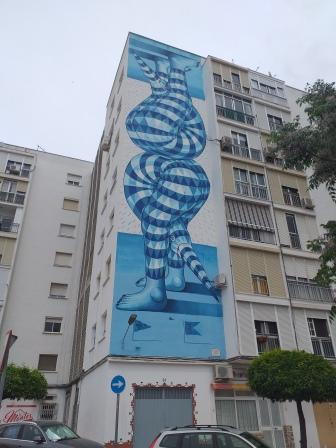LA FASE AZUL DE PAJARITO CURIOSO de André Farkos. C/ San Juan Bosco.
LA FASE AZUL DE PAJARITO CURIOSO Marisol Duarte Arbe, C1.2

Estepona is an open-air museum and the number of works of art displayed in its murals is increasing in both number and quality. A good example of this is ‘The Blue Phase of a Curious Little Bird’ by the Brazilian artist André Farkas ‘Treco’, which is located in the extension of San Lorenzo Avenue and won second prize in the Second International Murals Contest.
This mural is a semi-figurative inverted mirror image composed of two bodies that are joined at the back, like jesters or bird-headed mountebanks and that are bending over and looking for something behind their legs. It was possibly inspired by Picasso’s blue phase, emphasizing volume, light and shadows.
Treco leaves his signature at the top of the painting and, in addition to using geometric patterns to express movement and dynamism, he also leaves us with several enigmas to interpret, such as the flags with a symbol, the point at the bottom and the pronounced ankles. This mural could evoke different feelings when viewing this piece of art.
Be sure to visit it and feel the mood of the painting!

LA FASE AZUL DE PAJARITO CURIOSO Pilar Milán López, C1.2
This street wall painting, which emphasizes volume, light and shadows as inspired by Picasso’s blue phase, is part of the Estepona mural route. Farkos has essentially painted a monochromatic mural in shades of blue.
Given that art is open to interpretation, I am going to provide my own interpretation of “La Fase” as that of being a mural which particularly contrasts the old building in warm colours with this new stunning massive piece of street art.
This mural depicts two figures bending over as if they were a reflection of one another. You cannot tell if they are going to twirl or not, and maybe that is part of the magic of this piece; its capacity to give you the chance to imagine which direction the creature will take. In addition to that, the geometrical patterns have been utilized to express volume and motion. Furthermore, the blue colour is outstanding and powerful, making this bold colour crucial and powerful in this dreamlike graffiti. It appears that the artist is intending to convey a mirage of movement and activity, thus invoking an imaginary thought.
To conclude, I feel that I am unable to fully put into words what I feel looking at his masterpiece that could stand the test of time.
LA FASE AZUL DE PAJARITO CURIOSO Alejandro Olea Vergara, C1.2

For years now, Estepona campaigns for attracting tourists whilst beautifying the city have focused on easy-to-reach art. A host of talented international artists can currently show their inspiration on many building walls. “La Fase Azul de Pajarito Curioso” is one of these designs.
Painted by the Brazilian artist André Farkos, this mural depicts two symmetrical figures all in blue, who are bent over up to a point that they can touch the ground and the sky with their respective peaks, so they are birds…but not at all, since they have feet.
Not only was this mural one of the winners in the latest competition, but it also attracted the public’s attention for its peculiarity. This semi-figurative piece of art invokes offbeat feelings. What is up is down, this is the striking message that the compelling painter conveys with his thought-provoking mono-coloured drawing.
All in all, this representation strikes a chord with me. I find it every morning on my way to work, reminding me that all is connected, making me conscientious of my daily acts.
LA FASE AZUL DE PAJARITO CURIOSO Amani Aldihni García, C1.2
In this mural we can see a picture of two blue spheres that start with feet and end with a curved cone; a bird-shaped face. One of them is facing downwards, and the other is pointing to the sky. Their bodies are shaped with geometrical figures that help one to see the curved forms. Each one has an eye and a coned-beak mouth.

Their feet are pressed to the floor, in which case we find a top and bottom floor, so there’s no roof. There are shadows coming out of their feet, and on the base floor there are two different flags displayed. To finish off, the whole piece is painted in blue-coloured tones and small sparks or droplets of blue surround the bodies.
I believe this mural is trying to depict the struggle of one’s own problems, with the weight of everything on top of us. The curled up face represents the anxiety and the need to try and hide away from one’s problems. The feet are tied to the ground and do not let the person free themself from the difficulties, and the blue sparks remind me of rain or tears. Their eyes try to communicate the necessity of help and loss, and the need to cry, whilst the cone-shaped beak feels like a closed mouth incapable of speaking.
The blue colour represents the sadness and despair of the person. To finalise, and in my point of view, the two flags on the floor mean the limit between a struggling part of your life and a new, exciting and different part waiting for you.


